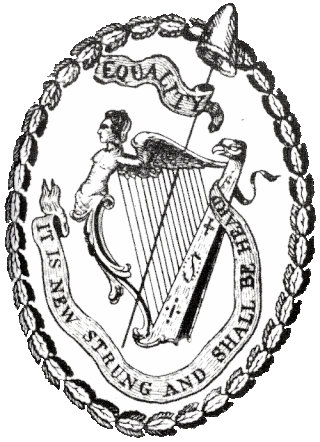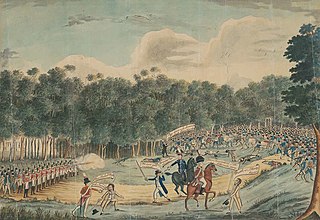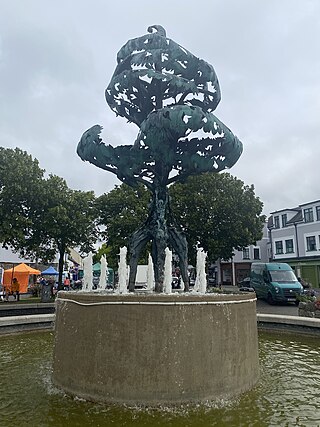Related Research Articles

The Society of United Irishmen was a sworn association, formed in the wake of the French Revolution, to secure representative government in Ireland. Despairing of constitutional reform, and in defiance both of British Crown forces and of Irish sectarian division, in 1798 the United Irishmen instigated a republican rebellion. Their suppression was a prelude to the abolition of the Irish Parliament in Dublin and to Ireland's incorporation in a United Kingdom with Great Britain.

The Irish Rebellion of 1798 was a popular insurrection against the British Crown in what was then the separate, but subordinate, Kingdom of Ireland. The main organising force was the Society of United Irishmen. First formed in Belfast by Presbyterians opposed to the landed Anglican establishment, the Society, despairing of reform, sought to secure a republic through a revolutionary union with the country's Catholic majority. The grievances of a rack-rented tenantry drove recruitment.

The Castle Hill convict rebellion was an 1804 convict rebellion in the Castle Hill area of Sydney, against the colonial authorities of the British colony of New South Wales. Led by veterans of the United Irish Rebellion of 1798, the poorly armed insurgents confronted the colonial forces of Australia on 5 March 1804 at Rouse Hill. Their rout in the resulting skirmish was hailed by loyalists as Australia's Vinegar Hill after the 1798 Irish Battle of Vinegar Hill, where rebels in Ireland were decisively defeated. The incident was the first major convict uprising in Australian history to be suppressed under martial law.

The Battle of Carlow took place in Carlow town, Ireland on 25 May 1798 when Carlow rebels rose in support of the 1798 rebellion which had begun the day before in County Kildare. The United Irishmen organisation in Carlow led by a young brogue-maker named Mick Heydon who had taken over the leadership following the arrest of the previous leader, Peter Ivers, who was arrested with several other leading United Irishmen at Oliver Bond's house in March of that year, had assembled on the night of the 24th and set off at dawn to attack the county town. Picking up more volunteers along the way, their numbers swelled to around 1,200 they marched completely unopposed.
Joseph Foveaux was a soldier and convict settlement administrator in colonial New South Wales, Australia. He was also a sheep grazier and breeder, being the largest landholder in New South Wales by 1800.

Maurice Margarot (1745–1815) is most notable for being one of the founding members of the London Corresponding Society, a radical society demanding parliamentary reform in the late eighteenth century.

Joseph Holt was a United Irish general and leader of a large guerrilla force which fought against British troops in County Wicklow from June–October 1798. He was exiled in 1799 to the colony of New South Wales where he worked as a farm manager for NSW Corp Paymaster Captain William Cox and later returned to Ireland in 1814.

Michael Dwyer was an insurgent captain in the Irish Rebellion of 1798, leading the United Irish forces in battles in Wexford and Wicklow., Following the defeat and dispersal of the rebel hosts, in July 1798 Dwyer withdrew into the Wicklow Mountains, and to his native Glen of Imaal, where he sustained a guerrilla campaign against British Crown forces.

John Murphy was an Irish Roman Catholic priest of the Roman Catholic Diocese of Ferns, who is mainly remembered for his central role in the Irish Rebellion of 1798 in County Wexford, which is sometimes known as the Wexford Rebellion. He led the rebels to one of their initial victories over a government militia at Oulart Hill, and in the following weeks became one of the rebellion's main leaders.

Patrick O'Donoghue (1810–1854), also known as Patrick O'Donohoe or O'Donoghoe, from Clonegal, County Carlow, was an Irish Nationalist revolutionary and journalist, a member of the Young Ireland movement.
Events from the year 1804 in Ireland.
Henry Fulton was a Church of Ireland curate who, as a United Irishman in 1798, was transported to New South Wales where in the Rum Rebellion, and the subsequent inquiries, he took the part of Governor William Bligh.

The Irish rebellion of 1803 was an attempt by Irish republicans to seize the seat of the British government in Ireland, Dublin Castle, and trigger a nationwide insurrection. Renewing the struggle of 1798, they were organised under a reconstituted United Irish directorate. Hopes of French aid, of a diversionary rising by radical militants in England, and of Presbyterians in the north-east rallying once more to the cause of a republic were disappointed. The rising in Dublin misfired, and after a series of street skirmishes, the rebels dispersed. Their principal leader, Robert Emmet, was executed; others went into exile.
Minerva was a merchantman launched in 1773 in the East Indies. She traded there for more than 20 years before she made three voyages for the British East India Company (EIC). The first EIC voyage was from 1796 to 1798. In 1799, she transported convicts from Ireland to Australia while under charter to the EIC. From Australia she sailed to Bengal, and then back to Britain. She underwent repairs in 1802 and then traveled to St Helena and Bengal for the EIC. She was lost in 1805 or 1806 under circumstances that are currently unclear.
Friendship was a three-decker merchantman, launched in 1793. She made three voyages for the British East India Company (EIC). During her first voyage, in 1796, a French privateer captured her, but the Royal Navy recaptured her. On the second, in 1799, she transported convicts from Ireland to Australia. She made a second voyage transporting convicts in 1817-18. On her way back she was broken up in 1819 at Mauritius after having been found unseaworthy.
Atlas was a sailing ship built in Quebec by William Baldwin and launched in 1801 for W. Beateson & Company, London.
James Dempsey, transported from Ireland following the 1798 rebellion, was the founder of the first Roman Catholic community in Australia and was a major contributor to the building of the first Catholic cathedral in Australia.
The North Gate Bridge Gaol was the prison for Cork City from the early 1700s. From 1798 it was used to hold United Irishmen prisoners from the Irish Rebellion of 1798 until they were transferred to the convict transports Minerva and Friendship in 1799 until they sailed for the penal colony of New South Wales in August of that year. Since it was built on a confined city centre site it was overcrowded and unhygienic, it was replaced by a more modern prison in Cork City Gaol in the early 1800s.
The Test of the Society of United Irishmen was a pledge taken by members of the Society of United Irishmen, a republican political society in the Kingdom of Ireland, who organised a 1798 insurrection. As the Society, despairing of reform, began to arm and drill, it amended the original wording to accommodate greater militancy and the need for secrecy. Under the Insurrection Act of 1796, the administration of the test became a capital offense. There were local variants, and overseas societies of United Irish exiles, convicts, and sympathisers framed their own tests.
References
- 1 2 Duran, Alan (1985–1986). "Peter Ivers of Carlow" (PDF). Carloviana, Journal of the Old Carlow Society: 4–5.
- ↑ Moore, Thomas (1855). The Life and Death of Lord Edward Fitzgerald. P.M. Haverty. p. 163.
- 1 2 Whelan, Fidelma (2005). "United Irishmen in Carlow in the 1790s". Carloviana, Journal of the Old Carlow Society: (29-38), 33–34.
- ↑ "Convict Records: Peter Ivers". convictrecords.com.au. Retrieved 25 January 2023.
- ↑ Whitaker, Anne-Maree (1994). Unfinished Revolution: United Irishmen in New South Wales, 1800-1810. Crossing Press. pp. 47–48. ISBN 978-0-646-17951-3.
- ↑ Donlan, Seán P. (2009). "Harold, James". Dictionary of Irish Biography. Retrieved 25 January 2023.
- 1 2 3 Porter, Gary (28 June 2019). "The Wicklow United Irishmen in New South Wales - PART 1". County Wicklow Heritage. Retrieved 25 January 2023.
- ↑ Chandler, Paul (2002). James Dempsey and John Butler: Pioneers of Australian Catholicism 1802-1838 (PDF). Middle Park, Vic., Australia: Carmelite Communications. p. 9. ISBN 1-87671723-8.
- ↑ Whitaker, Anne-Maree (1994). Unfinished Revolution: United Irishmen in New South Wales, 1800-1810. Crossing Press. p. 180. ISBN 978-0-646-17951-3.